1987




Kelvedon & Feering
|




Types 1 and 2, 30x30mm, printed by the East Essex District in sheets of 24 (6 rows of 4) on imperforate gummed paper.





Types 3 to 6, 30x30mm, printed by the East Essex District in sheets of 24 (6 rows of 4) on gummed paper. Forme rouletted about 5 (types 3 & 4) or perforated about 11 (types 5 & 6). A few of these may have been used late on in 1987, a few imperforate stamps from 1987 were re-used in 1988. First day covers bearing both stamps produced on plain white envelopes.
According to the organisers both values were produced in both rouletted & perforated versions but the compiler has only seen 5p rouletted and 10p perforated versions, including those on the first day cover.


Types 7 and 8, 30x30mm, printed by the East Essex District in sheets of 24 (6 rows of 4) on gummed paper. Line perforated about 6. First day covers bearing both stamps produced on plain white envelopes. Souvenir (first day of service) covers also produced on plain white envelopes in 1990. A few sheets of the 10p value were issued imperforate. Although the postal charge was raised to 10p anywhere from 1990 the old 5p stamps were used up in pairs.

Type 9, 30x30mm, printed by the East Essex District in sheets of 24 (6 rows of 4) on gummed paper. Line rouletted about 5½ but a few released imperforate. First day covers produced on plain white envelopes. Souvenir (first day of service) covers also produced on plain white envelopes in 1992. Note the circle now added around the value.

Type 10, 30x30mm, printed by the East Essex District in sheets of 24 (6 rows of 4) on gummed paper. Line rouletted about 6 to 6½. First day covers were produced on plain white envelopes.

Type 11, 30x30mm, printed by the East Essex District in sheets of 48 (6 rows of 8) on self-adhesive paper. Line rouletted about 6½ to 7. First day covers were produced on plain white envelopes.

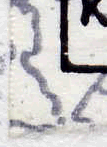
Type 12, 30x30mm, printed by the East Essex District in sheets of 48 (6 rows of 8) on self-adhesive paper. Used copies seen with 1995 datestamps appear to have been hand cut with slightly serrated scissors, not rouletted or perforated as before. The detail picture shows the indentations on the left-hand margin of the stamp.
No information available about the service (if any) provided in these years.


Types 12 and 13, designed by ? & printed by ? using an ink-jet printer onto A4 sheets of 14 self-adhesive labels (7 rows of 2), being printed three per label giving sheets of 42. When cut these can have all 4 corners square or 2 rounded at left or right with the other 2 square.

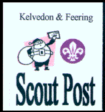

Types 15 to 17, designed by ? & printed by ? using an ink-jet printer onto A4 sheets of 14 self-adhesive labels (7 rows of 2), being printed three per label giving sheets of 42. When cut these can have all 4 corners square or 2 rounded at left or right with the other 2 square.
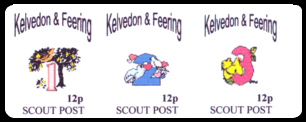
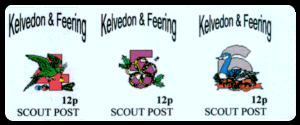
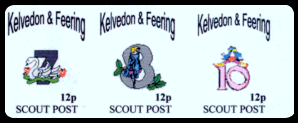
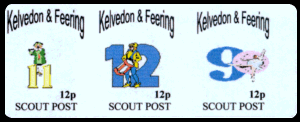
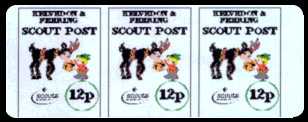
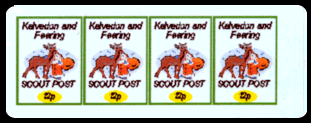
Types 18 to 31, designed by ? & printed by ? using an ink-jet printer onto A4 sheets of 14 self-adhesive labels (7 rows of 2), types 18-30 being printed three per label and type 31, 4 per label, giving sheets of 42 and 56 respectively. When cut types 30 & 31 can have all 4 corners square or 2 rounded at left or right with the other 2 square, types 18, 21, 24 & 27 have 2 rounded corners at the left, types 20, 23, 26 & 29 have two at the right, all others have 4 square corners.

Type P1 - used in 1987.
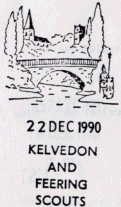
Type P2 - used from 1988 onwards.
| Year | 1981 | 1982 | 1983 | 1984 | 1985 | 1986 | 1987 | 1988 | 1989 | 1990 |
| Start | None | None | None | None | None | None | Dec 5 | Dec 3 | Dec 2 | Dec 1 |
| Printed | None | None | None | None | None | None | 2,400x5p 2,400x10p |
0 | 2,400x5p 2,400x10p |
0 |
| Carried | None | None | None | None | None | None | 2,677 | 2,700 | 3,000 | 3,000 |
| Year | 1991 | 1992 | 1993 | 1994 | 1995 | 1996 | 1997 | 1998 | 1999 | 2000 |
| Start | Dec 7 | Dec 5 | Nov 28 | Nov 25 | . | . | . | . | . | . |
| Printed | 3,600 | 0 | . | . | . | . | . | . | . | . |
| Carried | . | . | . | . | . | . | . | . | . | . |
| Year | 2001 | 2002 | 2003 | 2004 | 2005 | 2006 | 2007 | 2008 | 2009 | 2010 |
| Start | . | Dec 2 | . | . | . | . | . | . | . | . |
| Printed | . | . | . | . | . | . | . | . | . | . |
| Carried | . | . | . | . | . | . | . | . | . | . |
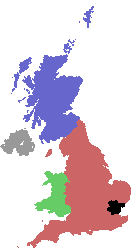
Return to Essex Index
Return to Alphabetic Index - K
Return to Scout County of Essex Index